| Number 49, Summer 2010 | 25.360 issues |
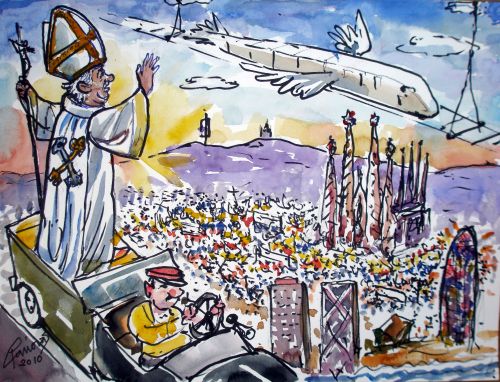
The Pope will personally consecrate the Sagrada Familia on Sunday, 7th of November, 2010
SUMMARY
1. GAUDÍ BIRTHDAY CELEBRATIONS
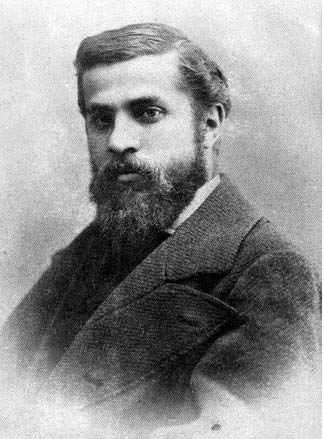 |
For the celebration of his anniversary we call upon all members of the GaudiClub to celebrate this together by raising a glass of cava at midnight on the 24th and eating a slice of hazelnut “coca” pastry while we say “HAPPY BIRTHDAY GAUDÍ" from the bottom of our hearts.
Two important events take place in the month of June. The anniversary of the birth of Gaudí on the 25th of June, 1852, at 9.30h in the morning he was born in Camp de Tarragona, some say in Reus, others in Riudoms and there are those who say he was born in Reusdoms.
Almost 75 years later, on the 10th of June, 1926, he died the victim of a traffic accident caused by a route 30 streetcar at the crossroads of Bailén and Gran Vía streets. |
- LA VERBENA DE SAN JUAN (THE NOCTURNAL FESTIVAL OF SAN JUAN)
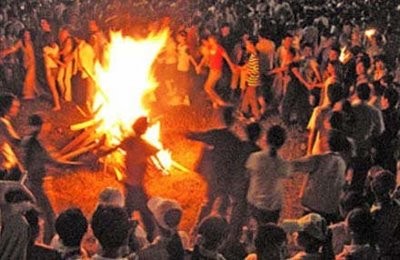
La Verbena de San Juan (The nocturnal festival of San Juan)
It is a deep-rooted tradition in many places to celebrate the arrival of the summer solstice around purifying bonfires and the anniversary of the birth of San Juan Bautista (St John the Baptist) who was born on the 24th of June, is also celebrated. Take note that the celebrations will be held on the night of the 23rd to 24th of June, although in reality the shortest night corresponds with the summer solstice, on the 21st of June.
In the majority of places this celebration consists in burning furniture and old junk in the street that the children of the house collect a few days before and save in order to build a great bonfire on this special night.
In ancient times, the arrival of the summer solstice was a negative sign. The fact that from that moment onwards the days got shorter and shorter and darkness gained ground over light, did not receive a positive interpretation. This is why a series of rites were performed for the purposes of offsetting this negative effect. One of the ancient pagan sun rites consisted in the preparation of some “cocas” (pastries) in a rounded shape to symbolise the solar disc, which were then eaten soaked in sweet wine.
The Romans sallied out on that night to gather verbena – a shrub-like plant from the same family as lemon verbena – with which they adorned their houses and gardens as they considered it to be a lucky plant. This is the origin of the celebration’s name, the origin of the paper strings and little coloured lamps with which we adorn the celebration venue.
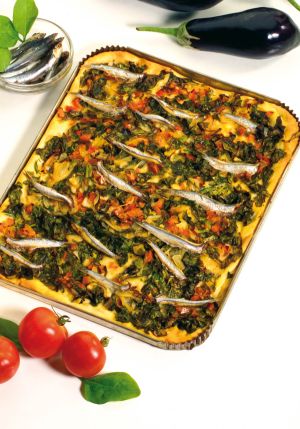
Vegetable Coca |
Ingredients:
For the dough:
- 1 kg of strong flour
- 150 gr. of lard
- 30 gr. of baker’s yeast
- 1/4 Litre of Water
- Salt
For the filling
- 150 gr. of sardines
- 1/4 Bunch of Spinach
- 1/4 Bunch of Swiss Chard
- 1 Onion
- 2 Cloves of Garlic
- 3 Tomatoes
- Parsley, Paprika, Pepper
- Olive Oil
- Salt
|
Preparation:
We dissolve the yeast in tepid water, add the lard and the flour little by little, work the dough, cover it with a cloth and leave to rest for 30 minutes, whereupon we knead it once again and leave the dough covered for a further 30 minutes, then lay out the dough on the baking tray which we have greased with oil. We now cut all the vegetables into small pieces, spread them across the dough, dress them, add chunks of tomatoes and we bake it for 5 minutes at 200 degrees, then remove the coca, add the sardines (clean and de-headed) and return to the oven to bake for 20 minutes at 180 degrees.
We owe this recipe to our member in Mallorca, Paquita Tomás. A prestigious cook and writer from the Balearic Islands and author of the book “Traditional cuisine with Paquita Tomás" who we deeply thank for her courtesy to our club.
Thank you very much, Paquita.

2. SAGRADA FAMÍLIA
- LATEST NEWS (4TH JUNE 2010): THE SAGRADA FAMILIA ARCHITECT SEEKS TO HALT THE BUILDING WORKS FOLLOWING THE UNESCO REPORT
The chief architect of the Sagrada Família, Jordi Bonet, today called for the Ministry of Public Works to halt the AVE works around the temple to avoid damage to Gaudí’s work.
Read full article

- UNESCO, IN THE TUNNEL: SEEING IS BELIEVING
The determination of the Sagrada Familia to halt and divert the AVE building work has two clear fronts: the judicial one, where various setbacks have been suffered despite the supervision of the works demanded by the Audiencia Nacional (National Court) and that of public opinion. It is there, as has already been announced, that international pressure will truly be brought to bear. To this effect, yesterday began the visit to Barcelona of two experts sent by Unesco, a German geologist and a German engineer, to undertake a study of the potential impact of the High Speed train building works on a monument which, on one of its facades – that of the Nativity, the only one directly built by Gaudí – is a World Heritage site.
Read full article

- THE POPE WILL CONSECRATE THE SAGRADA FAMILIA OF BARCELONA ON SUNDAY, 7TH OF NOVEMBER
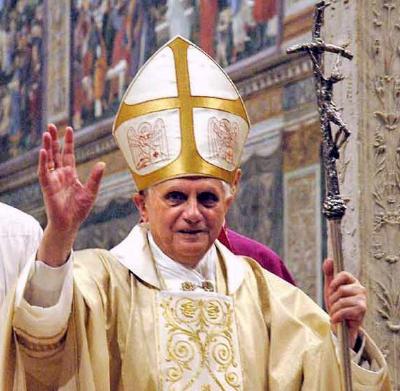
Benedict XVI will visit Barcelona on Sunday, 7th of November with the objective of consecrating the Expiatory Temple of the Sagrada Familia, in which the covering of the nave will be finalised this year, confirmed the Cardinal Archbishop of Barcelona, Lluís Martínez Sistach, in a press conference today.
Read full article
We are publishing a mini biography of the Pope in images given that he will be honouring us with his visit to Barcelona in November, BENEDICT XVI. Download it by clicking here.

- ADIF STUDIES WHETHER IT SHOULD PROTECT LA PEDRERA FROM THE AVE EXCAVATION
The unusual building of the Sagrada Família is the most compromised point on the route of the tunnel boring machine which opens up the AVE tunnel through the centre of Barcelona. But not the only one. Another modernist jewel, in this case made entirely by Antoni Gaudí, awaits the mechanical mole in the heart of the Paseo de Gràcia. The machine has already excavated 252 metres under Mallorca Street, between Biscaïa and Trinxant, and after a 15 day technical delay, will cross Meridiana in its route towards Sants. The AVE project does not include any special activities in La Pedrera, but a series of new geological probes have been completed around it. The infrastructure manager, Adif, confirms that the samples have given “results similar to those already obtained”. However, a working group has been created with the Universitat Politècnica de Catalunya and the engineering company Intemac to «evaluate whether additional work is necessary or redundant».
Read full article

- NEW DRILLING PROBES ARE UNDERTAKEN NEXT TO LA PEDRERA DUE TO THE AVE WORKS
A few days before the tunnel boring machine Barcino began to open up the AVE corridor that will join the future station of Sagrera with that of Santa – the starting pistol will be next Friday, according to Adif yesterday – the building works relating to the tunnel along its route, advance apace. These last have begun in front of la Pedrera with the objective of recording new subsoil data. This information will establish whether additional measures are required for the protection of the building prior to the passage of the large boring drill, which along this stretch will be under Provença. In order to establish this, drill probes are carried out.
Read full article

- THE INTERIOR NAVES OF THE SAGRADA FAMILIA ARE FINISHED
Sagrada Familia ready
The temple, finished
The interior naves of the Sagrada Família, ready
The space designed by Gaudí readies for the visit of the Pope on 7th of November
Barcelona now has its largest temple ready. The interior naves of the Sagrada Família are finished, after 128 years of work.
Read full article

3. OTHER NEWS
- GAUDÍ’S SOUNDBOARD (AMPLIFIER), PERFECTLY EXPENDABLE
Antoni Gaudí led the restoration of the Cathedral of Mallorca between 1903 and 1914 at the behest of Bishop Pere Joan Campins. The Catalan architect got many things right, made a few mistakes and left us works of art that can only be understood if placed within the context of the progress of that era.
Read full article

One of the ex-workers at Gaudí’s “Capricho”, José María Martínez García de la Rasilla, showed his discontent with the “poor financial management” of El Capricho during the last few years. He considers that the decisions taken by the current managing director and owner of the building, Taketo Kurosawa, throughout last year in an attempt to re-build the business, have precipitated the closure due to “a lack of judgement”.
Read full article

- ALMOST 400 SPECIMENS OF DRAGONS ADORN THE BUILDINGS OF BARCELONA
There are winged ones, ones with large jaws and terrifying tongues, with scathing scales, ferocious glare and feet with imposing claws. Other present a less threatening expression, without feet and wings, with their bodies evoking the sinuosity of the snake or the agitation of the lizard. They appear in unsuspected places, lying in wait below eaves, cornices and balconies, in the lintels of doorways, camouflaged in lamps, plinths or door handles, and behaving like rampant beings, climbers, proud, always primed to wield their mighty hooked claws.
Read full article

- LA LONJA HOSTS AN EXHIBITION ON MODERNISM WITH 90 WORKS OF ART LOANED BY THE NATIONAL ART MUSEUM OF CATALUÑA
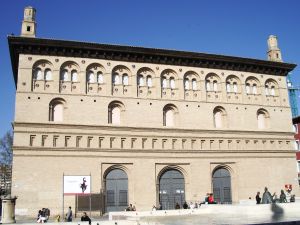
The exhibition can be seen until the 27th of June, “Modernism was a movement that went far beyond architecture” and in it “a great variety of styles” co-existed. The sample of works of art selected “are a reflection of the modernist spirit” and amongst them are three pieces from the sculptor from Aragon Pablo Gargallo (1881.1934): 'La Pareja' (The Couple), 'La Bestia del hombre' (The Beast of man) and 'El Ángel' (The Angel).
All the arts
These samples of modernist architecture, whose greatest representative is Antoni Gaudí (1852-1926), can be seen in the exhibition through the models of various buildings and the elements which decorated or formed part of the buildings such as chairs, tables, cupboards, decorative sculptures, flagstones or wrought iron.
In addition, it includes publicity posters, sculptures and paintings from the era belonging to the Gaudí, Puig i Cadafalch, Domènech i Montaner, Casas, Rusiñol, Nonell, Mir, Graner, Nonell, Busquets, Blay, Arnau and the Llimona brothers, amongst others.

- THE GUARDHOUSE AT THE PARK GÜELL RE-OPENS
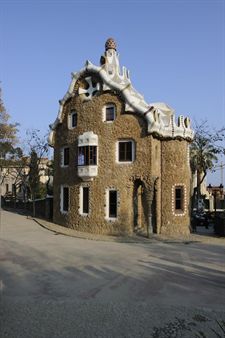
The Park Güell of Barcelona will re-open the Casa del Guarda (Guardhouse), totally rehabilitated, with the objective of increasing the profile of the architect Antoni Gaudí and his presence in Catalan modernism.
This will be possible thanks to the exhibition 'Güell, Gaudí and Barcelona: the expression of an urban ideal”, according to the statement made today by the project commissioner, Mireia Freixa, in the opening presentation.
Read full article

Vicens House (1883)
The Vicens House is the first work of Gaudí as an architect where he flaunted all his wisdom and which still remains as one of the most important monuments and the first one of its civil architectural line. That is why in 1927, the Vicens House received from the Barcelona City Council the much deserved price as the best and most emblematic building of the city.
The Vicens House is located at 24th Carolines Street in the popular district of Gracia in Barcelona.
Mr. Manuel Vicens Montaner, broker and not potter as he always thought, commissioned in between 1878 and 1880 to Gaudí a House on the lot he inherited from his mother in 1877. The land was in between the convent of Sisters of Charity of St. Vincent of Paül and a dead-end street perpendicular to the Carlines Street. Gaudí stuck the building to the dividing wall of the convent in order to obtain a big and spacious garden.
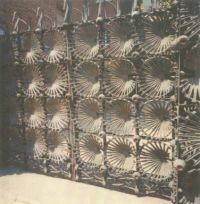
The original draft of Antoni Gaudí is dated March 1883 and was distributed in an elongated area of about 12 x 18 feet with basement, ground floor, first floor and attic. The ground floor was distributed around the room with a veranda, a room for smokers and two more rooms. The level of this floor was a little raised from the ground level to allow greater ventilation and lighting of the basement, an area intended for warehouses and storage room. The upper floor, where the bedrooms of the family were, was accessed via a staircase compensated with a U form. The ladder continued up to the attic, where the service’s bedrooms were located.
The Vicens House was built from two bays parallel to the dividing wall with the convent, which rely on wood joists and the Catalan vaults, except in the basement, which it has vaults. The sloping roof is a gable with four skirts and around it there is a small path that allows easy maintenance.
As in all works of Gaudí, vents and chimneys are profusely decorated with the same ceramic material of the facade and draw attention of any passerby. The pottery, decorated with floral motifs characteristic of the modernist era came from Girona. The facade walls are made of masonry view adorned with ceramic horizontal stripes representing the carnation flower of the Indies (Moorish carnation, in Catalan) that Gaudí saw on the ground before the project. From the second floor on, these lines become vertical, and its lining alternates green and white tiles. The windows are protected from the sun and onlookers with a beautiful geometrical square shutters.
The interior decoration of the house is notable for the large amount of plaster reliefs and paintings of birds and plants of nature, made with great detail. It also highlights the small smoker living room decorated in Arabic style.
In the south-west facade stands a small gallery open to the outside, with wooden blinds tilt same style as the shutters. On the ceiling of this gallery are drawn palm leaves pretending to be exposed.
Since 1899, the Vicens House is owned by the family Jover, who has tried to keep it in good condition, while respecting the design of Gaudí. Nevertheless, in 1925 asked the same architect an enlargement of the house, after having acquired the land it occupied the convent, which had been shot down, but he refused it because he was totally dedicated to the works of the Sagrada Família, and recommended the young architect Joan Serra de Martínez. These reforms consisted primarily on the expansion of the entire building in a corridor, closing the gallery, relocate the staircase to the bedrooms and add a room on the north side. Serra de Martínez consulted Gaudí before the reforms, and he gave his approval.
Another reform that had to be done, this time because of the widening of the Carolines Street, was to change the access of the house. If in Gaudí's original plan the main entrance was perpendicular to the street, this one had to be rotated 90 degrees south and the old one became windows. Serra de Martinez was commissioned to design grilles for these openings as they were now directly on the street (as you can see today). The source-circular fountain that adorned the area of the garden was also removed.
The Vicens House is declared a historic-artistic monument under the Ordinance of July 24th of 1969 and in July 2005 was declared World Heritage by UNESCO.
Although the building is privately owned, opens its doors once a year on the occasion of the Local Festivals, and it is possible to visit outside and stroll through its garden.
If you are interested in buying it contact us at gaudi@gaudiclub.com. You are welcome to send us your comments and suggestions.

4. COLLABORATIONS OF OUR MEMBERS
- 7.000 Km by bicycle!
Juan Díaz, member of our Gaudí Club, renowned photographer of the NGO Global Humanitaria and defender of human rights, has begun a solidarity project to build a school in Bodouakro (Ivory Coast) which 300 boys and girls from the area will be able to attend and will thereby have access to primary and secondary education.
To generate funds he will cover 7.000 Km by bicycle, from Barcelona to the Ivory Coast.
You can collaborate with this interesting initiative and find out more about it here:
www.masalladeldakar.org
Go for it, Juan, and good luck!
- NO TO THE CLOSURE OF GAUDÍ’S PARK GUELL AS A THEME PARK
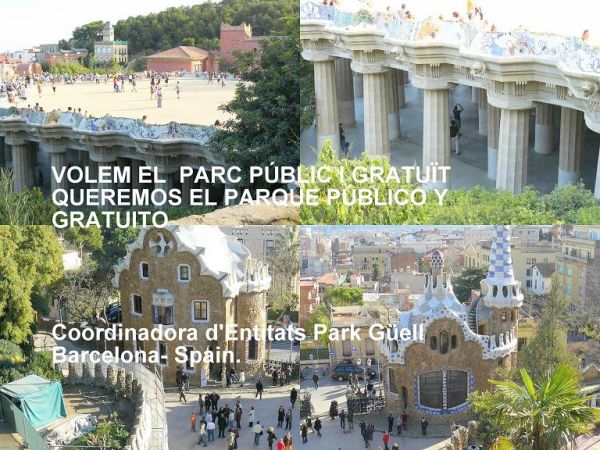
To whom it may concern, this is simply to make you aware that the Park Güell, work of Gaudí, of international renown, was a donation to the city of Barcelona by the descendants of the Güell family, with a cession document which indicated that the park must be public, and kept open to all people, with the people as co-owners and the town council as administrator. European directives have already indicated that there should be no first and second class citizens, with the local residents entering free and everyone else from other neighbourhoods and the city not, along with the rest of Catalunya and the Spanish state and its European neighbours.
We seek to broadcast this news of the imposition of the town council’s project, while in Barcelona there will be a popular referendum to find out whether the Avda. Diagonal should have one design or another, with this consultation process costing the public 2 million euros, and we hereby see that the city is living a dual culture, some with niceties and others with hard knocks.
If you can help maintain this park with the ideals of Eusebio Güell, creating his Catalan arcadia, cultured, ahead of its time, then help us, with your opinions, your advice, your documents, and perhaps amongst you there is a magnate or patron like the Count Güell who could help us financially to spread the word and draw up an integral plan adequate for the real needs of the park before the town council privatises it for commercial purposes. Please accept my warm regards.
Salvador Barrau Càrrec: President AVCV

5. OUR ONLINE SHOP
Not find what you were looking for? Check our index by prices..

We await your news, letters, essays, photos... Come on and participate!
Your comments and suggestions to gaudi@gaudiclub.com
Gaudinian greetings from Barcelona, thank you for continuing with us and until the next newsletter.
If you are a member and you cannot remember your identification number and password, send us an email to: info@gaudiclub.com
ASOCIACIÓN GAUDI & BARCELONA CLUB
Riera Sant Miquel, 16 3r.
08006 Barcelona
Telfs: +34 93 415 25 66
Fax: +34 93 415 30 33
http://www.gaudiclub.com
e-mail: gaudi@gaudiclub.com
|